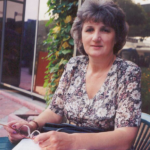The Chernobyl Secret Protocols: Lies in the Aftermath of Disaster
ENVIRONMENT, 9 May 2016
Alla Yaroshinskaya | The Right Livelihood Award Foundation - TRANSCEND Media Service
 Reflections of the 1992 RLA Laureate on the 30th anniversary of the Chernobyl nuclear disaster.
Reflections of the 1992 RLA Laureate on the 30th anniversary of the Chernobyl nuclear disaster.
In my journalistic archives there are mountains of classified Chernobyl documents from the USSR Communist Party and Soviet government. The price paid for these archives is tens of thousands of dead emergency responders and other victims of the fallout, as well as nine million people who lost their health and quality of life and are still surviving in the affected areas.
I only managed to gain access to the top-secret documents in 1991, when I was elected to the USSR Parliament as a representative of Zhitomir, a Ukrainian town just 140 km from Chernobyl. One December day, approaching the Parliament building, I spotted vast archives being loaded onto trucks. It struck me: the secret protocols of Chernobyl are about to be carted away!
I immediately decided to make copies. However, the Parliament’s special section blocked my attempts. It was a shocking revelation: all parliamentarians were evidently being watched by security services. I confronted Anatoly Burko, then the Head of this section, who responded, deadpan, that I would need the authorization of the entity that had originally classified them. Let me remind you that at this time, the Communist Party had already been banned and many of its former members were busy pondering life in KGB prison cells.
Nevertheless, I found a coveted copier at the offices of a daily newspaper. Back in my office, as I carefully returned the originals to a safe, a thought crossed my mind: What will happen to me and my family if the communists return to power tomorrow? I opened the safe again, took out the first protocol — the original — and put a photocopy in its place. (Lord, have mercy!)
It was revealed that the first meeting of the Politburo taskforce on Chernobyl was held on 29 April 1986 — a full three days after the reactor meltdown. Judging by the minutes of this and subsequent secret meetings, the number of affected civilians grew by the hour. From 4 May, information about the hospitalisation of local residents came flooding in, the count quickly reaching the thousands:
Confidential. Protocol no 12. May 12, 1986 (…)
10,198 people are currently undergoing hospital examinations and treatments, of which 345 people have symptoms of radiation sickness.
However, once the number of patients reached 10,000, they began to be discharged en masse. Here is the explanation for their apparent miraculous recovery:
Confidential. Protocol no 9. May 8, 1986 (…)
The USSR Ministry of Health has approved new rules for acceptable levels of public exposure to radiation, which exceed the previous limits by tenfold. In special cases there may be a 50-fold increase compared to the previously acceptable levels.
The Kremlin would stop at nothing to conceal its failure to contain the spread of radiation. Less than two months after the evacuation of civilians from the so-called “black zone”, a 30-kilometre radius from the epicentre, the authorities hastily reversed their policy to one of resettlement:
Confidential. Protocol no 29. June 23, 1986 (…)
The taskforce resolves to allow the return of children and pregnant women to settlements where the total estimated radiation exposure will not have exceeded 10 rem during the first year, and, by 1 October 1986, to resettle areas where the estimated radiation exposure will have exceeded 10 rem…
This protocol was signed by the Head of the State Meteorological Committee, who, just one month prior, had reported that such areas were considered dangerous for settlement.
The Politburo’s secret ‘recipes’ for the use of radioactive meat and milk also form a gripping chapter in the Kremlin-Chernobyl saga:
Top secret. Politburo Resolution of May 8, 1986 (…)
During the slaughter of cattle and pigs, it was established that hosing down animals with water, as well as removal of lymph nodes, produces meat suitable for human consumption.
Confidential. Protocol no 32. August 22, 1986 (…)
The State considers it expedient to stockpile meat with high content of radioactive substances… and to use it in the production of sausages and canned meat at the ratio of 1 to 10 with normal meat.
Five years after the Chernobyl disaster, in response to my parliamentary inquiry, Deputy Prosecutor General of the USSR admitted: “… from 1986 to 1989, over 47.5 thousand tonnes of contaminated meat and 2 million tonnes of contaminated milk were produced, thus putting in danger the health of some 75 million people…This led to higher mortality rates, as well as an increase in the number of malignant tumours, deformities, hereditary and somatic diseases…”
In the years that followed, states as far from Ground Zero as Bulgaria have prosecuted those who lied about the dangers of radiation. Yet back home, no one has been held accountable for the lawless aftermath of Chernobyl — neither under the reign of the communists who oversaw it nor under any democratic regime since. For 30 years, public prosecutors’ offices have kept their deathly silence — and today they keep it still.
__________________________________
Alla Yaroshinskaya is a Ukrainian-born journalist and writer. She received the Right Livelihood Award, widely known as the ‘Alternative Nobel Prize’, in 1992 for “revealing, against official opposition and persecution, the extent of the damaging effects of the Chernobyl disaster on local people”.
This article originally appeared on Transcend Media Service (TMS) on 9 May 2016.
Anticopyright: Editorials and articles originated on TMS may be freely reprinted, disseminated, translated and used as background material, provided an acknowledgement and link to the source, TMS: The Chernobyl Secret Protocols: Lies in the Aftermath of Disaster, is included. Thank you.
If you enjoyed this article, please donate to TMS to join the growing list of TMS Supporters.

This work is licensed under a CC BY-NC 4.0 License.